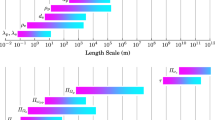Abstract
This paper describes a new numerical model of transport and transformation of gaseous and aerosol species in the atmosphere incorporating photochemistry, nucleation with neutral molecules and ions, condensation/evaporation, and coagulation. The results of calculations of the temporal variability of the calculated concentrations, the spectrum of aerosol particles in the atmosphere, and the rates of nucleation processes are presented. The results for the Northern Hemisphere in winter conditions indicate the significant role of the process of ion nucleation in the formation of aerosol. In addition to air ionization, temperature and relative humidity are among the key factors determining the dynamics of ion nucleation.




Similar content being viewed by others
Notes
The given estimate of the equilibrium vapor pressure H2SO4 was carried out taking into account the influence of the size of the condensation nuclei of the first mode [1].
REFERENCES
J. H. Seinfeld and S. N. Pandis, Atmospheric Chemistry and Physics. From Air Pollution to Climate Change (Wiley-Interscience, New York, 1997).
H. Akimoto, Atmospheric Reaction Chemistry (Springer, 2016).
D. Lowe and R. MacKenzie, “Review of polar stratospheric cloud microphysics and chemistry,” J. Atmos. Sol.-Terr. Phys. 70 (1), 13–40 (2008).
A. E. Aloyan, A. N. Yermakov, and V. O. Arutyunyan, “Formation of sulfate aerosols in the troposphere and lower stratosphere,” in Study of the Possibility of Climate Stabilization with New Technologies. Problems of Adaptation to Climate Change (Rosgidromet, Moscow, 2012), pp. 75–98 [in Russian].
A. E. Aloyan, A. N. Yermakov, and V. O. Arutyunyan, “Aerosols in the troposphere and lower stratosphere. Sulfate particles in northern latitudes,” Opt. Atmos. Okeana 31 (2), 136–142 (2018).
A. E. Aloyan, “Mathematical modeling of the interaction of gas species and aerosols in atmospheric dispersive systems,” Russ. J. Numer. Anal. Math. Modell. 15 (1–4), 211–224 (2000).
Y. Kurihara and R. E. Televa, “Structure of tropical cyclone developed in three-dimensional numerical simulation model,” J. Atmos. Sci. 31 (5), 893–919 (1974).
E. E. Ferguson, “Ion–Molecule Reactions in the Atmosphere,” in Kinetics of Ion–Molecule Reactions, Ed. by P. Ausloos (Springer, Boston, 1979).
K. D. Froyd and E. R. Lovejoy, “Experimental thermodynamics of cluster ions composed of H2SO4 and H2O. 1. Positive ions,” J. Phys. Chem. A 107 (45), 9800–9811 (2003).
F. Yu, “Ion-mediated nucleation in the atmosphere: Key controlling parameters, implications, and look-up table,” Geol. Soc. Am. Bull. 115, D03206 (2010). https://doi.org/10.1029/2009JD012630
M. S. Modgil, S. Kumar, S. N. Tripathi, and E. R. Lovejoy, “A parameterization of ion-induced nucleation of sulphuric acid and water for atmospheric conditions,” J. Geophys. Res. 110, D19205 (2005). https://doi.org/10.1029/2004JD005475
F. Yu and R. P. Turco, “Case studies of particle formation events observed in boreal forests: Implications for nucleation mechanisms,” Atmos. Chem. Phys. 8, 6085–6102 (2008).
D. J. Hofmann, “Measurement of the concentration nuclei profile to 31 km in the Arctic in January and comparison with Antarctic measurements,” Geophys. Res. Lett. 17 (4), 357–360 (1990).
A. E. Aloyan, Modeling the Dynamics and Kinetics of Gaseous Pollutants and Aerosols in the Atmosphere (Nauka, Moscow, 2008) [in Russian].
http://www.aim.env.uea.ac.uk/aim/aim.php.
Funding
This work was supported by the Russian Foundation for Basic Research, project nos. 18-05-00289 and 19-05-50007 (Microworld), as well as by State Task of the Institute for Computational Mathematics of the Russian Academy of Sciences and the Talrose Institute of Energy Problems of Chemical Physics no. AAAA-0047-2018-0012.
Author information
Authors and Affiliations
Corresponding authors
Rights and permissions
About this article
Cite this article
Aloyan, A.E., Yermakov, A.N. & Arutyunyan, V.O. Modeling the Influence of Ions on the Dynamics of Formation of Atmospheric Aerosol. Izv. Atmos. Ocean. Phys. 57, 104–109 (2021). https://doi.org/10.1134/S0001433821010023
Received:
Revised:
Accepted:
Published:
Issue Date:
DOI: https://doi.org/10.1134/S0001433821010023




